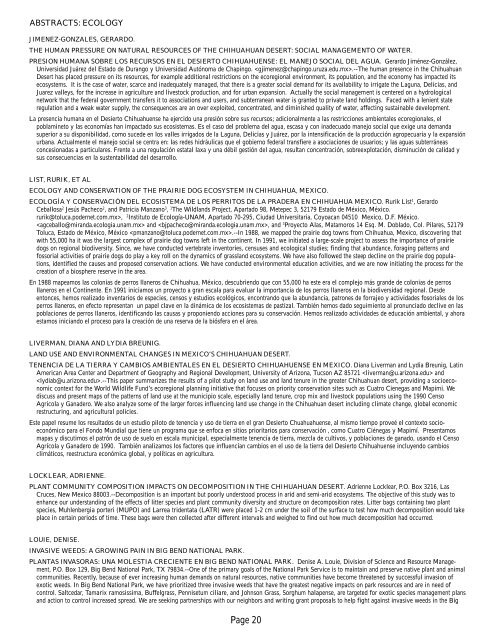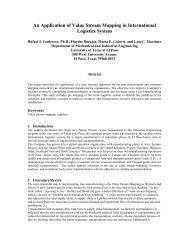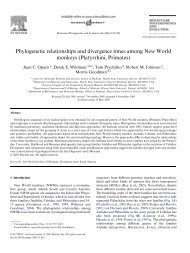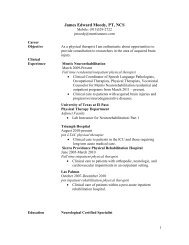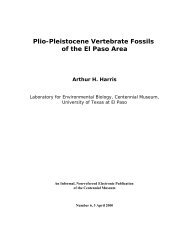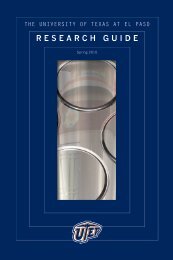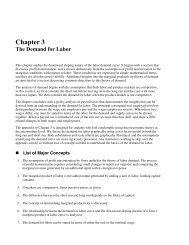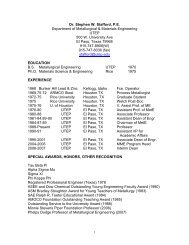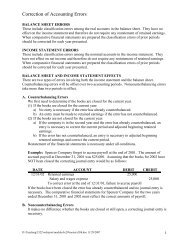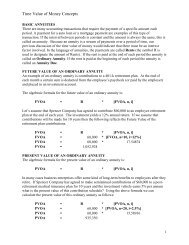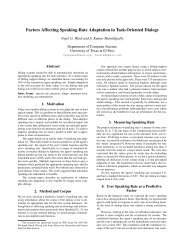Sym - Abstracts - University of Texas at El Paso
Sym - Abstracts - University of Texas at El Paso
Sym - Abstracts - University of Texas at El Paso
You also want an ePaper? Increase the reach of your titles
YUMPU automatically turns print PDFs into web optimized ePapers that Google loves.
ABSTRACTS: ECOLOGY<br />
JIMENEZ-GONZALES, GERARDO.<br />
THE HUMAN PRESSURE ON NATURAL RESOURCES OF THE CHIHUAHUAN DESERT: SOCIAL MANAGEMENTO OF WATER.<br />
PRESION HUMANA SOBRE LOS RECURSOS EN EL DESIERTO CHIHUAHUENSE: EL MANEJO SOCIAL DEL AGUA. Gerardo Jiménez-González,<br />
Universidad Juárez del Estado de Durango y Universidad Autónoma de Chapingo. .--The human presence in the Chihuahuan<br />
Desert has placed pressure on its resources, for example additional restrictions on the ecoregional environment, its popul<strong>at</strong>ion, and the economy has impacted its<br />
ecosystems. It is the case <strong>of</strong> w<strong>at</strong>er, scarce and inadequ<strong>at</strong>ely managed, th<strong>at</strong> there is a gre<strong>at</strong>er social demand for its availability to irrig<strong>at</strong>e the Laguna, Delicias, and<br />
Juarez valleys, for the increase in agriculture and livestock production, and for urban expansion. Actually the social management is centered on a hydrological<br />
network th<strong>at</strong> the federal government transfers it to associ<strong>at</strong>ions and users, and subterranean w<strong>at</strong>er is granted to priv<strong>at</strong>e land holdings. Faced with a lenient st<strong>at</strong>e<br />
regul<strong>at</strong>ion and a weak w<strong>at</strong>er supply, the consequences are an over exploited, concentr<strong>at</strong>ed, and diminished quality <strong>of</strong> w<strong>at</strong>er, affecting sustainable development.<br />
La presencia humana en el Desierto Chihuahuense ha ejercido una presión sobre sus recursos; adicionalmente a las restricciones ambientales ecoregionales, el<br />
poblamineto y las economías han impactado sus ecosistemas. Es el caso del problema del agua, escasa y con inadecuado manejo social que exige una demanda<br />
superior a su disponibilidad, como sucede en los valles irrigados de la Laguna, Delicias y Juárez, por la intensificación de la producción agropecuaria y la expansión<br />
urbana. Actualmente el manejo social se centra en: las redes hidráulicas que el gobierno federal transfiere a asociaciones de usuarios; y las aguas subterráneas<br />
concesionadas a particulares. Frente a una regulación est<strong>at</strong>al laxa y una débil gestión del agua, resultan concentración, sobreexplotación, disminución de calidad y<br />
sus consecuencias en la sustentabilidad del desarrollo.<br />
LIST, RURIK, ET AL<br />
ECOLOGY AND CONSERVATION OF THE PRAIRIE DOG ECOSYSTEM IN CHIHUAHUA, MEXICO.<br />
ECOLOGÍA Y CONSERVACIÓN DEL ECOSISTEMA DE LOS PERRITOS DE LA PRADERA EN CHIHUAHUA MEXICO. Rurik List 1 , Gerardo<br />
Ceballosa 2 Jesús Pacheco 2 , and P<strong>at</strong>ricia Manzano 3 , 1 The Wildlands Project, Apartado 98, Metepec 3, 52179 Estado de México, México.<br />
rurik@toluca.podernet.com.mx>, 2 Instituto de Ecología-UNAM, Apartado 70-295, Ciudad Universitaria, Coyoacan 04510 Mexico, D.F. México.<br />
and , and 3 Proyecto Alas, M<strong>at</strong>amoros 14 Esq. M. Doblado, Col. Pilares, 52179<br />
Toluca, Estado de México, México .--In 1988, we mapped the prairie dog towns from Chihuahua, Mexico, discovering th<strong>at</strong><br />
with 55,000 ha it was the largest complex <strong>of</strong> prairie dog towns left in the continent. In 1991, we initi<strong>at</strong>ed a large-scale project to assess the importance <strong>of</strong> prairie<br />
dogs on regional biodiversity. Since, we have conducted vertebr<strong>at</strong>e inventories, censuses and ecological studies; finding th<strong>at</strong> abundance, foraging p<strong>at</strong>terns and<br />
fossorial activities <strong>of</strong> prairie dogs do play a key roll on the dynamics <strong>of</strong> grassland ecosystems. We have also followed the steep decline on the prairie dog popul<strong>at</strong>ions,<br />
identified the causes and proposed conserv<strong>at</strong>ion actions. We have conducted environmental educ<strong>at</strong>ion activities, and we are now initi<strong>at</strong>ing the process for the<br />
cre<strong>at</strong>ion <strong>of</strong> a biosphere reserve in the area.<br />
En 1988 mapeamos las colonias de perros llaneros de Chihuahua, México, descubriendo que con 55,000 ha este era el complejo más grande de colonias de perros<br />
llaneros en el Continente. En 1991 iniciamos un proyecto a gran escala para evaluar la importancia de los perros llaneros en la biodiversidad regional. Desde<br />
entonces, hemos realizado inventarios de especies, censos y estudios ecológicos, encontrando que la abundancia, p<strong>at</strong>rones de forrajeo y actividades fosoriales de los<br />
perros llaneros, en efecto representan un papel clave en la dinámica de los ecosistemas de pastizal. También hemos dado seguimiento al pronunciado declive en las<br />
poblaciones de perros llaneros, identificando las causas y proponiendo acciones para su conservación. Hemos realizado actividades de educación ambiental, y ahora<br />
estamos iniciando el proceso para la creación de una reserva de la biósfera en el área.<br />
LIVERMAN, DIANA AND LYDIA BREUNIG.<br />
LAND USE AND ENVIRONMENTAL CHANGES IN MEXICO’S CHIHUAHUAN DESERT.<br />
TENENCIA DE LA TIERRA Y CAMBIOS AMBIENTALES EN EL DESIERTO CHIHUAHUENSE EN MEXICO. Diana Liverman and Lydia Breunig, L<strong>at</strong>in<br />
American Area Center and Department <strong>of</strong> Geography and Regional Development, <strong>University</strong> <strong>of</strong> Arizona, Tucson AZ 85721 and<br />
.--This paper summarizes the results <strong>of</strong> a pilot study on land use and land tenure in the gre<strong>at</strong>er Chihuahuan desert, providing a socioeconomic<br />
context for the World Wildlife Fund’s ecoregional planning initi<strong>at</strong>ive th<strong>at</strong> focuses on priority conserv<strong>at</strong>ion sites such as Cu<strong>at</strong>ro Cienegas and Mapimi. We<br />
discuss and present maps <strong>of</strong> the p<strong>at</strong>terns <strong>of</strong> land use <strong>at</strong> the municipio scale, especially land tenure, crop mix and livestock popul<strong>at</strong>ions using the 1990 Censo<br />
Agricola y Ganadero. We also analyze some <strong>of</strong> the larger forces influencing land use change in the Chihuahuan desert including clim<strong>at</strong>e change, global economic<br />
restructuring, and agricultural policies.<br />
Este papel resume los resultados de un estudio piloto de tenencia y uso de tierra en el gran Desierto Chuahuahuense, al mismo tiempo proveé el contexto socioeconómico<br />
para el Fondo Mundial que tiene un programa que se enfoca en sitios prioritarios para conservación , como Cu<strong>at</strong>ro Ciénegas y Mapimí. Presentamos<br />
mapas y discutimos el p<strong>at</strong>rón de uso de suelo en escala municipal, especialmente tenencia de tierra, mezcla de cultivos, y poblaciones de ganado, usando el Censo<br />
Agrícola y Ganadero de 1990. También analizamos los factores que influencían cambios en el uso de la tierra del Desierto Chihuahuense incluyendo cambios<br />
climáticos, reestructura económica global, y políticas en agricultura.<br />
LOCKLEAR, ADRIENNE.<br />
PLANT COMMUNITY COMPOSITION IMPACTS ON DECOMPOSITION IN THE CHIHUAHUAN DESERT. Adrienne Locklear, P.O. Box 3216, Las<br />
Cruces, New Mexico 88003.--Decomposition is an important but poorly understood process in arid and semi-arid ecosystems. The objective <strong>of</strong> this study was to<br />
enhance our understanding <strong>of</strong> the effects <strong>of</strong> litter species and plant community diversity and structure on decomposition r<strong>at</strong>es. Litter bags containing two plant<br />
species, Muhlenbergia porteri (MUPO) and Larrea trident<strong>at</strong>a (LATR) were placed 1-2 cm under the soil <strong>of</strong> the surface to test how much decomposition would take<br />
place in certain periods <strong>of</strong> time. These bags were then collected after different intervals and weighed to find out how much decomposition had occurred.<br />
LOUIE, DENISE.<br />
INVASIVE WEEDS: A GROWING PAIN IN BIG BEND NATIONAL PARK.<br />
PLANTAS INVASORAS: UNA MOLESTIA CRECIENTE EN BIG BEND NATIONAL PARK. Denise A. Louie, Division <strong>of</strong> Science and Resource Management,<br />
P.O. Box 129, Big Bend N<strong>at</strong>ional Park, TX 79834.--One <strong>of</strong> the primary goals <strong>of</strong> the N<strong>at</strong>ional Park Service is to maintain and preserve n<strong>at</strong>ive plant and animal<br />
communities. Recently, because <strong>of</strong> ever increasing human demands on n<strong>at</strong>ural resources, n<strong>at</strong>ive communities have become thre<strong>at</strong>ened by successful invasion <strong>of</strong><br />
exotic weeds. In Big Bend N<strong>at</strong>ional Park, we have prioritized three invasive weeds th<strong>at</strong> have the gre<strong>at</strong>est neg<strong>at</strong>ive impacts on park resources and are in need <strong>of</strong><br />
control. Saltcedar, Tamarix ramosissima, Buffelgrass, Pennisetum ciliare, and Johnson Grass, Sorghum halapense, are targeted for exotic species management plans<br />
and action to control increased spread. We are seeking partnerships with our neighbors and writing grant proposals to help fight against invasive weeds in the Big<br />
Page 20


